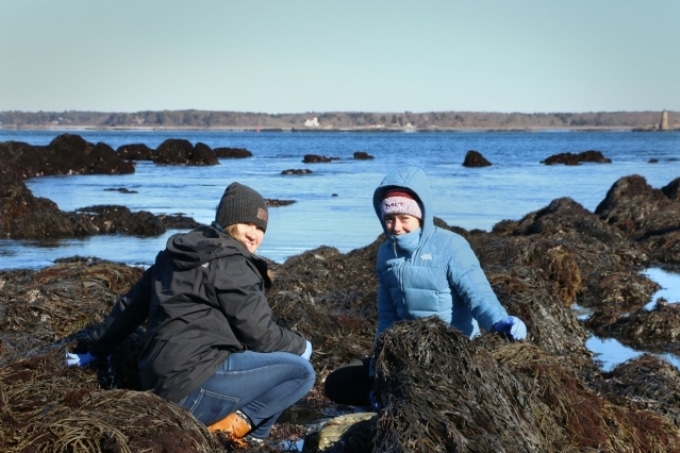Dec 28 2018
When a nor’easter struck the East Coast in early January 2018, a record-breaking high tide made several streets in Boston inaccessible, and in Boston’s Seaport District, seawater rushed down Seaport Boulevard.
 Valerie Muldoon (left), a third-year mechanical engineering student, and biological engineering student Jenna Melanson explore a coastal ecosystem during a field trip to Odiorne Point State Park in New Hampshire. (Image credit: MIT Sea Grant)
Valerie Muldoon (left), a third-year mechanical engineering student, and biological engineering student Jenna Melanson explore a coastal ecosystem during a field trip to Odiorne Point State Park in New Hampshire. (Image credit: MIT Sea Grant)
The Aquarium subway station was forced to close by a deluge of water that poured down the steps leading down to the station. Just a week later, a team of students in a dry classroom on MIT’s campus discussed ways in which coastal cities such as Boston can cope with worsening floods caused by rising sea levels.
We live in a coastal city, so obviously we are being significantly impacted by sea level rise. We talked about the bad nor’easter earlier in January and brainstormed ways to mitigate the flooding.
Valerie Muldoon, third-year mechanical engineering student, MIT.
Muldoon and her colleagues were enrolled in 2.981 (New England Coastal Ecology), a class that meets at the time of MIT’s Independent Activities Period. The MIT Sea Grant College Program, which is affiliated with MIT’s Department of Mechanical Engineering, offers this course.
Juliet Simpson, a research engineer, and Carolina Bastidas, a research scientist, are MIT Sea Grant instructors who use the 4-week class to introduce students to the biological composition of coastal ecosystems, to the critical role played by there regions in protecting the environment, and to the impacts of human interaction and climate change on them.
“We want to give a taste of coastal communities in New England to the students at MIT — especially those who come from abroad or other parts of the U.S.,” stated Bastidas, a marine biologist who focuses her research primarily on coral and oyster reefs.
Muldoon, a double minor in energy studies and environment and sustainability, stated that she was “so excited to see a Course 2 class on coastal ecology.”
“I’m passionate about protecting the environment, so the topic really resonated with me,” she noted.
The course starts with an introduction to various types of coastal ecosystems seen in the New England area, for example, eelgrass meadows, rocky intertidal regions, kelp forests, and salt marshes. The course instructors not only offer an outline of the composition of each environment but they also discuss the physiology of the innumerable organisms living in them.
Midway through the course, students get to know about the influence of human effects such as eutrophication, climate change, and increased development on coastal habitats.
“We focus on climate change as it impacts coastal communities like rocky shores and salt marshes,” stated Simpson, a coastal ecologist who studies how plants and algae respond to human interference. “There are a lot of interesting implications for sea level rise for intertidal organisms.”
Increase in sea level, for instance, has driven organisms living in salt marshes to migrate upland. Variations in both air and water temperature also have a severe impact on the inhabitants of coastal regions.
As temperatures rise, all of those organisms are going to need to adapt or the communities are going to change, possibly dramatically.
Juliet Simpson, Research Engineer, MIT.
The protection of coastal ecosystems has widespread implications that reach beyond the plants and animals living there since they provide a natural defense against climate change. Several coastal regions are natural hotspots for carbon capture and sequestration. Enormous amounts of carbon are captured by seagrass meadows and salt marshes. This carbon can be stored for several thousand years in peat.
“I was shocked at how much carbon the plants in these ecosystems can hold through sequestration,” recalled Muldoon.
It is highly crucial to protect these areas to ensure this natural sequestration of carbon continues and to prevent leaking out of carbon already stored there. Coastal ecosystems are also conducive to protecting coastal cities, such as Boston, from flooding caused by an increase in sea level.
“We talk about the ecology of coastal cities and how flooding from storms and sea level rise impacts human communities,” added Simpson.
The class ends in a field trip to Odiorne Point State Park in New Hampshire. There, students can interact with the communities they have studied. Students gather data related to the species living in the adjacent rocky shore and salt marsh with the help of fundamental techniques in ecology.
Bastidas and Simpson will expand the scope of the class beyond New England in a new course—2.982 (Ecology and Sustainability of Coastal Ecosystems)—to be offered in fall 2019.
Although the impacts of climate change on coastal ecosystems often seem to be dreadful, the instructors want the focus of the students to be on the positive.
Rather than have students focus on the gloom and doom aspect, we want to encourage them to come up with novel solutions for dealing with climate change and carbon emissions.
Carolina Bastidas, Research Scientist, MIT.
Muldoon envisions an exceptional role for mechanical engineers such as herself in developing such solutions.
“I think it’s so important for mechanical engineering students to take classes like this one because we are definitely going to be needed to help mitigate the problems that come with sea level rise,” she stated.